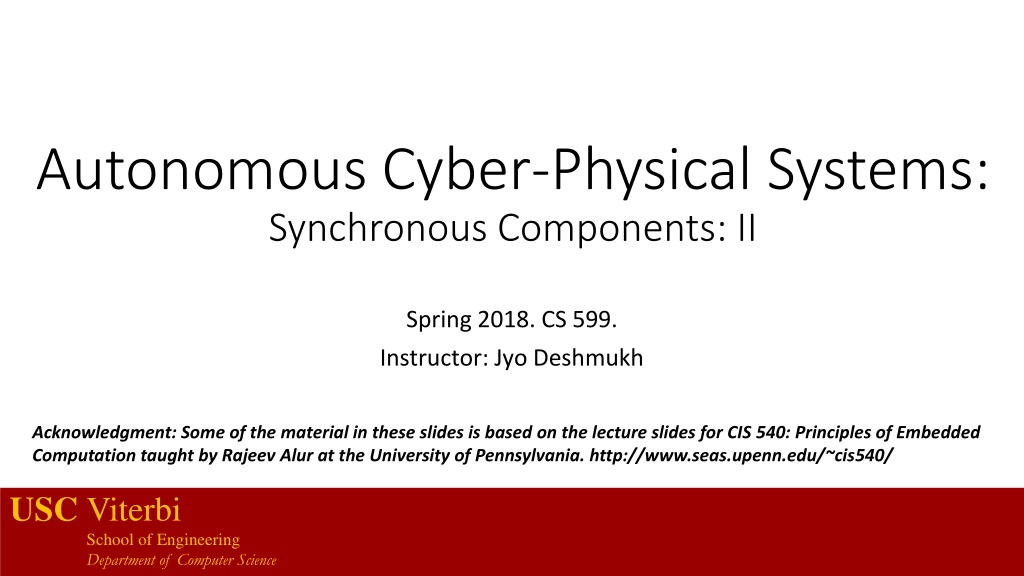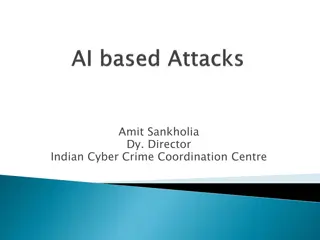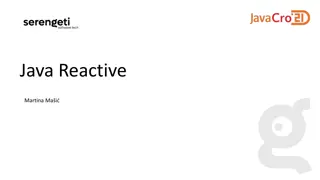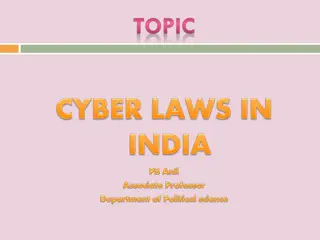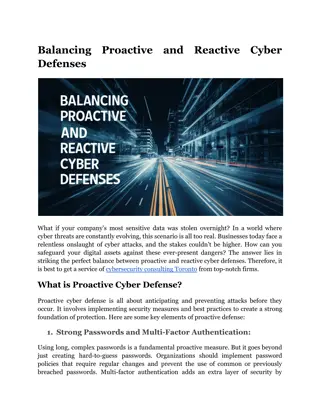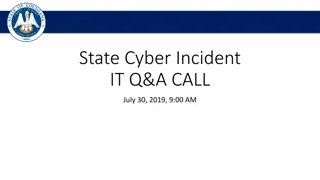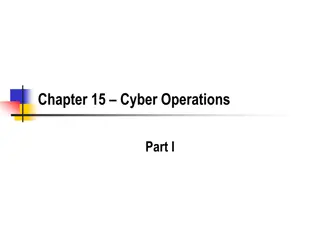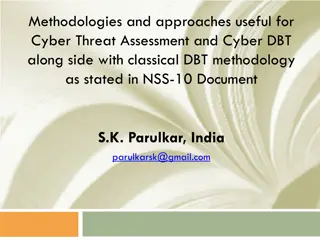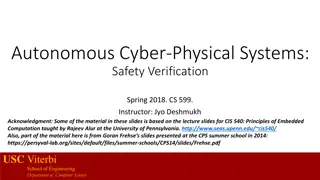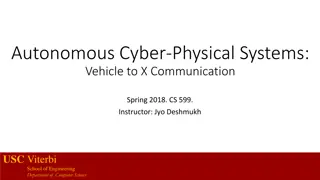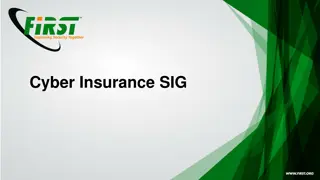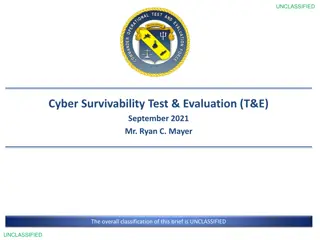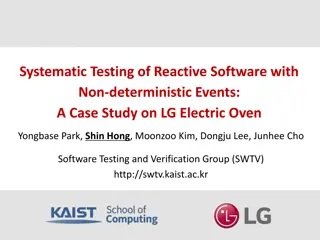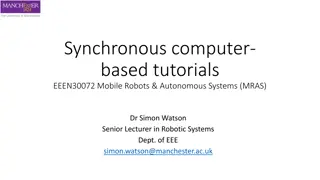Understanding Synchronous Reactive Components in Autonomous Cyber-Physical Systems
Synchronous Reactive Components (SRCs) play a crucial role in Autonomous Cyber-Physical Systems, involving inputs, state variables, outputs, and updates. Valuation functions, input valuations, and state valuations are key concepts in formalizing SRCs. Explore the definition, variables, valuations, and semantics of updates in SRCs to delve deeper into their functioning.
Uploaded on Oct 05, 2024 | 0 Views
Download Presentation

Please find below an Image/Link to download the presentation.
The content on the website is provided AS IS for your information and personal use only. It may not be sold, licensed, or shared on other websites without obtaining consent from the author. Download presentation by click this link. If you encounter any issues during the download, it is possible that the publisher has removed the file from their server.
E N D
Presentation Transcript
Autonomous Cyber-Physical Systems: Synchronous Components: II Spring 2018. CS 599. Instructor: Jyo Deshmukh Acknowledgment: Some of the material in these slides is based on the lecture slides for CIS 540: Principles of Embedded Computation taught by Rajeev Alur at the University of Pennsylvania. http://www.seas.upenn.edu/~cis540/ USC Viterbi School of Engineering Department of Computer Science
Synchronous Reactive Component: Recap Set of Typed Inputs, Typed Outputs, Typed State Variables, Updates Every round: read input, update state, update output bool in bool out bool x := 0 out:=x ; x:= in USC Viterbi School of Engineering Department of Computer Science 2
Today Finish Synchronous Components Cruise Controller Model USC Viterbi School of Engineering Department of Computer Science 3
Lets Formalize an SRC SRC is defined as a tuple: (?,?,?,?), where: Symbol Designation Examples ? { ??1,??2} {} ?1,?2,?3 {} {???1,???2} {} Set of Inputs ? Set of State Variables ? Set of Outputs ? ? ??1 ??2 ;???1 ? ?1 ??1+ ??2;?2 ??3;???:= ?1 Set of Updates USC Viterbi School of Engineering Department of Computer Science 4
Variables vs. Valuations A valuation function maps each variable to some value Input valuation maps each input to some value in the set of possible inputs, e.g.: if input variable is of type bool, in each round, the valuation function maps an input variable to some value in {0, 1} if a state variable is of type int, in each round, the state-valuation maps state variable in each round to some value in {int_min, -1, 0, 1, .. int_max} Let set of input, output, and state values be ??,??,?? USC Viterbi School of Engineering Department of Computer Science 5
What are the ??,??,?? for these SRCs? bool in bool out bool in int y:= 0 bool z:= 0 bool x := 0 int out out:=y ; if (z==0) else z := in out:=x ; x:= in y:= y + 1 y:= y-1 ??= 0,1 ,??= 0,1 ,??= {0,1} ??= 0,1 ,??= int {0,1},??= int USC Viterbi School of Engineering Department of Computer Science 6
Semantics of updates & initialization Semantics of the initialization function: At time/round 0, maps the state variables to some specified value (or values) in ?? Semantics of the update function (some sequence of conditionals and assignments): ?/? q , where ? A set ? of reactions where each reaction is of the form: ? is the old value of the state variables, ? is the new value of the state variables, ? is the value of the input in that round, and ? is the value of the output ? is a subset of ?? ?? ?? ?? USC Viterbi School of Engineering Department of Computer Science 7
Reactions for Delay 0/0 0 bool in bool out 0 bool x := 0 1/0 1 0 out:=x ; x:= in 0/1 0 1 1/1 1 1 USC Viterbi School of Engineering Department of Computer Science 8
Deterministic Component An SRC is deterministic if: It has a single initial state Updates ensure that for every state ? and input ?, there is a unique state ? and output ? such that (?,?,?,? ) is a reaction Determinism means for same input sequence, you get same state/output sequence every single time Note: Nondeterminism is useful for modeling uncertainty/unknown It is not the same as probabilistic/random choice! USC Viterbi School of Engineering Department of Computer Science 9
Reactions for LossyDelay Set of reactions: 0/00 bool in bool out 0 bool x := 0 1/00 1/01 0 0 out:=x ; x:= choose{in,x} 0/11 0/10 1 1 LossyDelay 1/11 Motivation: Abstraction, Missing input 1 USC Viterbi School of Engineering Department of Computer Science x:= choose(y,z) nondeterministically assigns x with either y or z 10
Input-Enabled Component An SRC is input-enabled if: For every state ? and input ?, there is some state ? and some output ? such that (?,?,?,? ) is a reaction Component that is not input-enabled is making assumptions about the context in which it will be used! USC Viterbi School of Engineering Department of Computer Science 11
Not input-enabled component: missing reactions 0/0 0 Set of reactions contains only 2 reactions now! bool in bool out 0 bool x := 0 1/0 1 0 Motivation: Blocking communication if (in==0) out:=x 0/10 1 1/11 1 USC Viterbi School of Engineering Department of Computer Science 12
Extended State Machines Commonly used to describe behavior of MBD models Does this ESM remind you of something? (in==1)? out 0 0 (in==0)? out 0 (in==0)? out 1 1 (in==1)? out 1 USC Viterbi School of Engineering Department of Computer Science 13
Component Switch: What does this do? bool press bool out int x := 0 bool q := 0 switch (q) case 0: if (press==1) q:= 1 case 1: if (press==0) & (x < 10) q:=1; x:= x+1 elseif (press==1) or ( x >= 10) q:=0; x:= 0 end end USC Viterbi School of Engineering Department of Computer Science 14
ESM corresponding to Switch SRC q = 0 : off = 1 : on int x 0 off (press==1)? (press==0)? on (press==0) & (x<10) ? x x + 1 (press==1) & (x 10) ? x 0 USC Viterbi School of Engineering Department of Computer Science 15
ESM notation Implicit variable called mode that is a discrete state variable over some finite enumeration. Here: {on, off} int x 0 (press==0)? off (press==1)? SRC reaction may correspond to mode-switch Each mode-switch has: Guard: (press==0) & (x<10) and Update: x:= x+1 (press==0) & (x<10) ? x x + 1 on (press==1) & (x 10) ? x 0 USC Viterbi School of Engineering Department of Computer Science 16
ESM execution Start in mode off; initial state = (off,0) Sample executions: int x 0 (???,0) 0 (???,0) 1 (??,0) 0 (??,1) 0 (??,5) 1 (???,0) (???,0) 0 (???,0) 1 (??,0) 0 (??,1) 0 (??,10) 0 (???,0) (press==0)? off (press==1)? (press==0) & (x<10) ? x x + 1 on (press==1) or (x 10) ? x 0 USC Viterbi School of Engineering Department of Computer Science 17
ESM transitions could be nondeterministic! int x 0 (press==0)? off (press==1)? (press==0) & (x 10) ? x x + 1 on (press==1) or (x 10) ? x 0 USC Viterbi School of Engineering Department of Computer Science 18
SRC: Finite-state Components Component is finite state if all variables are over finite types bool in int y:= 0 bool z:= 0 bool in bool out int out bool x := 0 out:=y ; if (z==0) else z := in y:= y + 1 out:=x ; x:= in y:= y-1 Not FS! FS USC Viterbi School of Engineering Department of Computer Science 19
Combinational component Combinational components have no state variables bool out bool ??1,??2 out ??1 ??2 Hardware logic gates are combinational! USC Viterbi School of Engineering Department of Computer Science 20
Event-triggered Components SRC: each component participates in each round Synchronous assumption can become cumbersome if we want some components to not participate in some rounds Hack: Event-triggered component Event is a special input/output variable, which can be absent or present Event variable has value only if it is present Syntax: e? True if e is present e!a e gets the value of the assignment a USC Viterbi School of Engineering Department of Computer Science 21
Event-triggered Copy bool in event(bool) flag bool x := 0 if clk? then flag!x; x:=in event(bool) clk USC Viterbi School of Engineering Department of Computer Science 22
Event-triggered Components No need to execute in a round where triggering events are absent event(bool) min event(bool) sec nat x := 0 if sec? then x:=x+1; if (x==60) min! 1; x:=0 end end USC Viterbi School of Engineering Department of Computer Science 23
Putting together a complex SRC from smaller SRCs Main rule: can share input variables, but states and output variables need to be distinct Must be careful to rename states and output variables when instantiating an SRC bool temp bool in bool in bool out bool x1 := 0 bool x := 0 temp:=x1 ; x1:= in out:=x ; x:= in Delay1 Delay USC Viterbi School of Engineering Department of Computer Science 24
Parallel Composition bool temp bool out bool in Delay1 Delay2 Gives semantics of connecting two SRCs DoubleDelay = Delay1 || Delay2 Rules for composing components: define initialization, input/output/state variables and reactions in terms of components USC Viterbi School of Engineering Department of Computer Science 25
Compatibility of Components Can have common input variables Cannot have common output variables One component: one output Cannot have common state variables Each component knows only its state. Can rename state variables to avoid conflicts Input variable of one can be output of another USC Viterbi School of Engineering Department of Computer Science 26
Defining Outputs bool temp bool out bool in Delay1 Delay2 Outputs of DoubleDelay are {temp, out} (Default is to make every output available to the external world) If C1 has outputs ?1 and C2 has outputs ?2, then the parallel composed SRC has outputs ?1 ?2 USC Viterbi School of Engineering Department of Computer Science 27
Defining Inputs bool temp bool out bool in Delay1 Delay2 Input of DoubleDelay is {in}. Note temp is not an input of the product If C1 has inputs ?1and outputs ?1 and C2 has inputs ?2 and outputs ?2, then the parallel composed SRC has inputs (?1 ?2) (?1 ?2) A variable is an input if it is not some components output USC Viterbi School of Engineering Department of Computer Science 28
Defining states bool temp bool out bool in Delay1 Delay2 State variables of DoubleDelay :{?1,?2} C1 s state variables : ?1and C2 s state variables: ?2then (C1||C2) s state variables: (?1 ?2) A state of the parallel composed SRC is a pair ?1,?2 where ?1 is a state of C1 and ?2 is a state of C2. States of composed SRC take values in ??1 ??2. So if C1 has ? states and C2 has ? states, C1 || C2 has ? ? states. USC Viterbi School of Engineering Department of Computer Science 29
Defining Initialization bool temp bool out bool in Delay1 Delay2 Initialization code can be interpreted to have run in any order If Delay1 s init code is: ?1 0, and Delay2 s init code is ?2 0, then DoubleDelay s init code is ?1 0;?2 0 In this example, initial state variable value is (0,0) USC Viterbi School of Engineering Department of Computer Science 30
Reactions bool temp bool out bool in Delay1 Delay2 Reactions are consistent with executing update statement of Delay1 before that of Delay2 If components not connected acyclically, composition (e.g. feedback) becomes problematic! USC Viterbi School of Engineering Department of Computer Science 31
Cruise Controller Example ThrottleController event(real) F event second event cruise Clock event inc CruiseController event rotate Sensor event dec nat speed event(nat) cruiseSpeed Driver Inputs Display USC Viterbi School of Engineering Department of Computer Science 32
Sensors Rotation Sensor: Wheel speed sensor or vehicle speed sensor Type of a tachometer Counts number of rotations per second and as the wheel radius is known, can compute the linear speed of the car (From Porter and Chester Institute slides on Google Image Search) USC Viterbi School of Engineering Department of Computer Science 33
Actuator ThrottleController ThrottleController is an actuator that gets a force/torque required to adjust the throttle plate which leads to tracking the desired speed event(real) F event second event cruise Clock event inc CruiseController event rotate Sensor event dec nat speed event(nat) cruiseSpeed Display USC Viterbi School of Engineering Department of Computer Science 34
Decomposing CruiseController further USC Viterbi School of Engineering Department of Computer Science 35
MeasureSpeed SRC nat speed event rotate nat count := 0, s:=0 event second if rotate? count:=count + 1; if second? s:= round( K* count); count:=0; speed:=s MeasureSpeed USC Viterbi School of Engineering Department of Computer Science 36
Next time Asynchronous Components, Timed Components USC Viterbi School of Engineering Department of Computer Science 37
